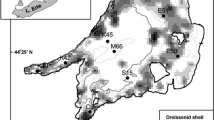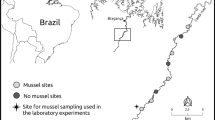ABSTRACT
Nonindigenous species may exert strong effects on ecosystem structure and function. The zebra mussel (Dreissena polymorpha) has been attributed with profound changes in invaded ecosystems across eastern North America. We explored vertical profiles of water flow velocity and chlorophyll a concentration in western Lake Erie, over rocky substrates encrusted with Dreissena, to assess the extent to which mussels influence coupling between benthic and pelagic regions of the lake. Flow velocity was always low at surveyed sites (less than or equal to 2.9 cm s-1) and declined in direct proximity to the lakebed. Mean chlorophyll a concentration was also low (less than 5μg L-1) at all sites and depths. Chlorophyll a concentration was positively correlated with distance above lakebed and was lowest (0.3μg L-1) directly adjacent to the lakebed. Spatial patterns of zooplankton grazers could not explain observed vertical gradients in chlorophyll concentration. Hydrodynamic modeling revealed that filtering effects of Dreissena in a nonstratified, shallow basin depend mainly on upstream chlorophyll concentration, intensity of turbulent diffusion, feeding efficiency of the mussel colony, and the distance downstream from the leading edge of the mussel colony. In contrast to widespread perceptions that molluscs reduce phytoplankton concentration only adjacent to the lakebed, modeling scenarios indicated that depletion occurs throughout the water column. Depletion was, however, inversely proportional to distance above the lakebed. Simulation results are consistent with field-based observations made in shallow water habitats populated by large Dreissena populations in the Great Lakes and elsewhere. Results from this study indicate that zebra mussels strongly enhance coupling between pelagic and benthic regions in shallow lakes. Enhanced coupling between these regions explains, in part, high population densities of Dreissena and of many benthic invertebrates in ecosystems invaded by zebra mussels.
Similar content being viewed by others
Author information
Authors and Affiliations
Additional information
Received 14 July 1998; accepted 25 March 1999.
Rights and permissions
About this article
Cite this article
MacIsaac, H., Johannsson, O., Ye, J. et al. Filtering Impacts of an Introduced Bivalve (Dreissena polymorpha) in a Shallow Lake: Application of a Hydrodynamic Model. Ecosystems 2, 338–350 (1999). https://doi.org/10.1007/s100219900084
Issue Date:
DOI: https://doi.org/10.1007/s100219900084




